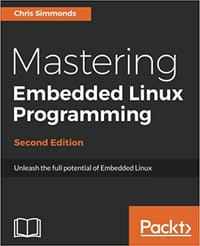Key Features
Discover how to build and configure reliable embedded Linux devicesThis book has been updated to include Linux 4.9 and Yocto Project 2.2 (Morty)This comprehensive guide covers the remote update of devices in the field and power management
Book Description
Embedded Linux runs many of the devices we use every day, from smart TVs to WiFi routers, test equipment to industrial controllers - all of them have Linux at their heart. Linux is a core technology in the implementation of the inter-connected world of the Internet of Things.
The comprehensive guide shows you the technologies and techniques required to build Linux into embedded systems. You will begin by learning about the fundamental elements that underpin all embedded Linux projects: the toolchain, the bootloader, the kernel, and the root filesystem. You'll see how to create each of these elements from scratch, and how to automate the process using Buildroot and the Yocto Project.
Moving on, you'll find out how to implement an effective storage strategy for flash memory chips, and how to install updates to the device remotely once it is deployed. You'll also get to know the key aspects of writing code for embedded Linux, such as how to access hardware from applications, the implications of writing multi-threaded code, and techniques to manage memory in an efficient way. The final chapters show you how to debug your code, both in applications and in the Linux kernel, and how to profile the system so that you can look out for performance bottlenecks.
By the end of the book, you will have a complete overview of the steps required to create a successful embedded Linux system.
What you will learn
Evaluate the Board Support Packages offered by most manufacturers of a system on chip or embedded moduleUse Buildroot and the Yocto Project to create embedded Linux systems quickly and efficientlyUpdate IoT devices in the field without compromising securityReduce the power budget of devices to make batteries last longerInteract with the hardware without having to write kernel device driversDebug devices remotely using GDB, and see how to measure the performance of the systems using powerful tools such as perk, ftrace, and valgrindFind out how to configure Linux as a real-time operating system
About the Author
Chris Simmonds is a software consultant and trainer living in southern England. He has almost two decades of experience in designing and building open-source embedded systems. He is the founder and chief consultant at 2net Ltd, which provides professional training and mentoring services in embedded Linux, Linux device drivers, and Android platform development. He has trained engineers at many of the biggest companies in the embedded world, including ARM, Qualcomm, Intel, Ericsson, and General Dynamics. He is a frequent presenter at open source and embedded conferences, including the Embedded Linux Conference and Embedded World. You can see some of his work on the Inner Penguin blog.
Table of Contents
Starting outLearning about ToolchainsAll about BootloadersPorting and Configuring the KernelBuilding a Root filesystemSelecting a Build SystemCreating a storage strategyUpdating software in the fieldInterfacing with Device DriversStarting up: the init programPower managementLearning about processes and threadsManaging MemoryDebugging with GDBProfiling and tracingReal time programming
About the Author
Chris SimmondsChris Simmonds is a software consultant and trainer living in southern England. He has almost two decades of experience in designing and building open-source embedded systems. He is the founder and chief consultant at 2net Ltd, which provides professional training and mentoring services in embedded Linux, Linux device drivers, and Android platform...

